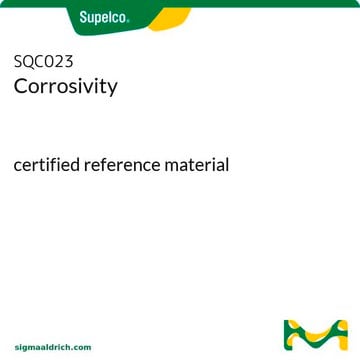SQC003
BNAs in Soil
certified reference material
Se connecterpour consulter vos tarifs contractuels et ceux de votre entreprise/organisme
About This Item
Code UNSPSC :
41116107
Nomenclature NACRES :
NA.24
Produits recommandés
Qualité
certified reference material
CofA (certificat d'analyse)
current certificate can be downloaded
Fabricant/nom de marque
RTC SQC-003
Technique(s)
HPLC: suitable
gas chromatography (GC): suitable
Matrice
soil
Application(s)
environmental
Format
matrix material
Température de stockage
2-8°C
Description générale
This Certified Reference Material (CRM) is produced and certified in accordance with ISO 17034 and ISO/IEC 17025. All information regarding the use of this CRM can be found on the certificate of analysis.
Application
Refer to the product′s Certificate of Analysis for more information on a suitable instrument technique. Contact Technical Service for further support.
Autres remarques
Values of analytes vary lot to lot. Some lots may not contain all analytes.
Analyte
Description
1,2,3,4-Tetrachlorobenzene
1,2,3,5-Tetrachlorobenzene
1,2,3-Trichlorobenzene
1,2,4,5-Tetrachlorobenzene
1,2,4-Trichlorobenzene
1,2-Dichlorobenzene
1,3,5-Trichlorobenzene
1,3-Dichlorobenzene
1,4-Dichlorobenzene
1-Chloronaphthalene
2,2′-Oxybis(1-Chloropropane)
2,3,4,6-Tetrachlorophenol
2,3-Dimethylphenol
2,4,5-Trichlorophenol
2,4,6-Trichlorophenol
2,4-Dichlorophenol
2,4-Dimethylphenol
2,4-Dinitrophenol
2,4-Dinitrotoluene (2,4-DNT)
2,5-Dimethylphenol
2,6-Dichlorophenol
2,6-Dimethylphenol
2,6-Dinitrotoluene (2,6-DNT)
2-Amino-1methylbenzene
2-Chloronaphthalene
2-Chlorophenol
2-Methyl-4,6-dinitrophenol
2-Methylnaphthalene
2-Methylphenol (o-Cresol)
2-Nitroaniline
2-Nitrophenol
3+4-Methylphenol (m+p-Cresol)
3,3′-Dichlorobenzidine
3,4-Dimethylphenol
3,5-Dimethylphenol
3-Methylphenol (m-Cresol)
3-Nitroaniline
3-Nitrophenol
4-Bromophenyl phenyl ether
4-Chloro-3-methylphenol
4-Chloroaniline
4-Chlorophenyl phenylether
4-Methylphenol (p-Cresol)
4-Nitroaniline
4-Nitrophenol
Acenaphthene
Acenaphthylene
Acetophenone
Aniline
Anthracene
Atrazine
Benzaldehyde
Benzidine
Benzo(a)anthracene
Benzo(a)pyrene
Benzo(b)fluoranthene
Benzo(b+k)fluoranthene
Benzo(g,h,i)perylene
Benzo(k)fluoranthene
Benzoic acid
Benzyl alcohol
Biphenyl
bis(2-Chloroethoxy)methane
bis(2-Chloroethyl) ether
bis(2-Chloroisopropyl) ether
bis(2-Ethylhexyl) phthalate (DEHP)
Butyl benzyl phthalate
Caprolactam
Carbazole
Chrysene
Di-n-butyl phthalate
Di-n-octyl phthalate
Dibenzo(a,h)anthracene
Dibenzofuran
Diethyl phthalate
Dimethyl phthalate
Fluoranthene
Fluorene
Hexachlorobenzene
Hexachlorobutadiene
Hexachlorocyclopentadiene
Hexachloroethane
Indeno(1,2,3-cd) pyrene
Isophorone
Maleic anhydride
n-Nitroso-di-n-propylamine
n-Nitrosodimethylamine
n-Nitrosodiphenylamine
Naphthalene
Nitrobenzene
Pentachlorobenzene
Pentachlorophenol
Phenanthrene
Phenol
Pyrene
Pyridine
Total cPAH
Total PAH
Afficher tout (98)
Mention d'avertissement
Danger
Mentions de danger
Conseils de prudence
Classification des risques
Aquatic Chronic 3 - Carc. 1B - Skin Sens. 1
Classe de danger pour l'eau (WGK)
WGK 3
Choose from one of the most recent versions:
Déjà en possession de ce produit ?
Retrouvez la documentation relative aux produits que vous avez récemment achetés dans la Bibliothèque de documents.
Aleksandra Ukalska-Jaruga et al.
Molecules (Basel, Switzerland), 25(3) (2020-02-06)
Pesticides belong to a group of xenobiotics harmful to humans and wildlife, whose fate and activity depends on their susceptibility to degradation. Therefore, the monitoring of their residue level in agricultural soils is very important because it provides very valuable
Notre équipe de scientifiques dispose d'une expérience dans tous les secteurs de la recherche, notamment en sciences de la vie, science des matériaux, synthèse chimique, chromatographie, analyse et dans de nombreux autres domaines..
Contacter notre Service technique








